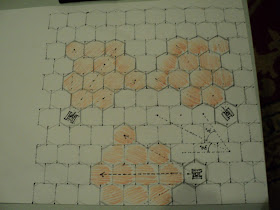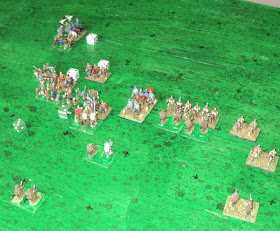 |
| View of the battlefield from the Russian perspective. |
After what was quite an enjoyable game, I thought it a jolly wheeze to have myself a kind of debriefing. This was to discuss or sort out some points that cropped up. Feel free to add your own observations by way of comment.
1. The Map.
The acute reader will observe from the following maps that I did not translate the original Portable Wargame hex-map to my square-grid table exactly. The maps are, in sequence: the table as played, the hex-map; and how the table would have looked translated column by column.
 |
| Map of the field as p[played, a 10x10 grid. As the original was just 9 hexes wide, here the far right column of squares was eliminated by the addition of a river. |
You will see that rather than retain the 8 by 9 cell arrangement I stretched it to 10 by 9. That was not exactly an arbitrary decision - apart from wanting to use as much of the board as possible. But I felt that an 'exact' translation had certain effects that altered the nature - even the apparent density - of the terrain. Check out the hex-map. Immediately in front of the fieldworks you will see that a clear line of empty hexes can be traced running from one side of the field to the other. On the map following, there is no such clear line, bearing in mind all moves and ranges are measured orthogonally only.
 |
| The Portable Wargame original hex-grid map - 9 columns wide; 8 hexes deep. |
Now, you might argue that that is simply by the by, and that is reasonable. But I preferred to retain where possible the ability to move or to see according to the original map. That implied a certain stretching in depth. In my square map, there is that traceable clear line. Mind you, I have only just noticed this particular feature. I was more concerned at the time about the terrain effects of the woods in front of the cojoined fieldworks on the German right.
 |
| How the map would have looked translated column by column |
2. Effect of SP vs 'Sudden Death'.
Someone asked about the whether the square grid might have improved the Russian chances of victory. I thought not. But I do recall thinking as I set up this game, that the 'Sudden Death' system would have been relatively advantageous to the Germans. The attackers simply could not afford 'take a few' hits in order to press home an attack.
I now don't recall sufficiently the order of losses, but it might have been that the Germans would have lost their anti-tank and an MG unit before they could offer any resistance (the long run of red cards); or that the Russians would have lost a tank and two infantry units before they could properly get to grips.
The strength point system gives you a bit of flexibility about whether of not to persist in an attack, or to hang on in defence, in the face of losses.
...
 |
| Work in Progress: Proposed Mechanised Brigade of the Not Quite Mechanised type |
3.Rules and their interpretation.
Two issues came up here ... and kind of a third, but that one I'll treat under a different heading.
The first was the loss of the commander. During this Combined Arms Assault, the commander, sharing the fieldworks with 4th MG Coy, shared their fate when it was overrun (Rolled for commander's survival: a six. He didn't. End of Oberst Willi Fredrickson).
Did the 'nominal' 6SP go with him? At the time, I thought not. Wrong. Played 'per spec' that loss would have placed the Germans in a state of passive defence. Something to bear in mind for future games!
That the rule set was unspecific about this ought perhaps to have told me that indeed the vanished 6SP did count towards the Exhaustion Point. What I did was to 'second-guess' the rules.
The other was the matter of multiple close assaults against the one target. I supposed that all units involved received one die. That is the way the rules read to my mind, but that is based upon this assumption: that multiple attackers against one unit is one close combat. What if that assumption were wrong? Although he didn't express it in quite this way, Ross Mac gave it as his opinion that in fact there are, in the case of a three-to-one fight, in effect three close combats. The weaker side gets to roll in defence of all three; BUT as each is taken in turn, and the results are applied before the next in the series, the defender might not survive long enough to fight all three combats.
I like the idea, not so much for its verisimilitude, but a sense I have that it would be the more exciting method. That is always a consideration, methinks.
 |
| Proposed NQM Mech Bde - organisation. |
4. On a clear day....
The 'third' point perhaps deserves a heading of its own. As there is no specific rule mentioning this, I infer that the only impediments to visibility is the terrain: hills, forests, towns and such. Given a clear line, a man from one end of the table can see to the other. Given the on table ranges of artillery, I am inclined to want a limit to how far one can see, even if we take binoculars and range-finders into account.
The other reason - apart from the artillery ranges, this is - is that I would like to allow room for reconnaissance. Having said that, writing up rules for recon might not be so easy, when only the 'moving' player can shoot. I'm not talking units concealed from the players, mark you, but concealment from the enemy. And what do you do about artillery preparation? I'll leave these matters open for now, but may revisit them another time with some ideas.
Not Quite Mechanised Mechanised Formation.
Finally: on a different topic, and just to add colour to an otherwise monochromatic posting, I've added some pics of my proposed Soviet Mechanised Brigade, organised as follows:
- HQ: commander and flag, with vehicle (White scout car in this instance)
- Logistics, 1 Zis truck
- 3 Rifle battalions comprising 3 'fighting' stands (rifles with an LMG on one of them) and 3 support stands (1 MMG, 1 PTRD or PTRS anti-tank rifle, 1 light or medium mortar or infantry gun). I'd probably make the last the command/support stand;
- 1 tank regiment with 2 medium tanks (T34s here, but I also have Shermans)
- 1 Recon unit with Armoured Car and jeep;
- 1 Anti-tank gun unit with 1x45mm or 57mm anti-tank gun
- 1 Field Artillery unit with 1x76mm gun
- 1 Anti-Air unit (absent until I get hold of some models - jeep mounted quad MG or 37mmAA guns)
- 1 'Motorcycle' Company (this one with a .30cal MG mounted)
Apart from the towed weapons with their tows, the units will fit quite comfortably within the 4-inch square space of my little gridded table. We'll have to give that a try some time...
With different scaling, this formation might also stand in for a Mechanised Corps.
 |
| NQM Mech Bde - seen through the Microsoft 'Zeke' filter. |















































